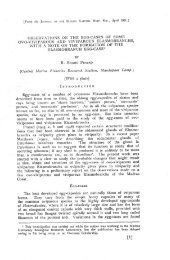PDF - Eprints@CMFRI
PDF - Eprints@CMFRI
PDF - Eprints@CMFRI
Create successful ePaper yourself
Turn your PDF publications into a flip-book with our unique Google optimized e-Paper software.
111<br />
Material:<br />
Gulf of Suez:<br />
Gulf of Aqaba:<br />
Northern R. S.:<br />
T. Aviv NS<br />
Jerus. SLR<br />
T. Aviv NS<br />
Basel<br />
USNM<br />
HLM<br />
1912 (EtTur);8417 (Ras el Kanisa).<br />
367- 1, 2 (Marsa Murach) ; 457 (EI Kura); 664 (Marsa Abu Zabad).<br />
263,266,267, 268, 13 37-1,2 (Eilar); 1891, 3204,4848,4958, 4959,<br />
4971,4989 (Dahab); 481 7,4833,4841, 4885 (Ras Arantur).<br />
PW 73566, 569,576 (Eilar, 50-55 m) .<br />
Wa<br />
EC<br />
53,54 (Ghardaqa).<br />
482 (Ras Abu Suma); 432 (Safaga (lsl.); 67 ( Koseir, duplicate from<br />
KLUNZINGER) ; 308 (Ras Abu Hagar).<br />
Central R. S.: USNM<br />
P. Sud.<br />
Wa<br />
Sa<br />
55 (Dongonab).<br />
23, 62 , 108 (Sanganeb R.).<br />
HLM RM 81,82, 118 (Wi ngate R.).<br />
X2 : 8-15 (Shaab Anbar).<br />
Southern R. S.: HLM X2: 9- 23,13- 5 (Sarso Isl. ).<br />
EC 396 (Massawa).<br />
Distribution: Red Sea eastward to Fanning Isis. A wide-spread Indo-Pacific species.<br />
Favia wisseli new species<br />
(Plate 28, Figs. 1- 3)<br />
One specimen collected during the 2 nd Xarifa Expedition does not fit into any of the species of Favia<br />
known to the present au thors. Though there is only one specimen, its characters are very remarkable that<br />
we are describing it under a new specific name.<br />
Dec r ip t ion 0 f the hoi 0 t y p e: Corallum submassive , but very light. The entire surface with<br />
endo- and exorhecal vesicles, so that the coral looks blistery as in Favia speciosa. The intercorallite walls,<br />
though appearing fused, make holes when pressed, thus showing that the area is filled only with exothecal<br />
vesicles and the fusion is not complete and the wall nor solid. Peritheca 1 to 2 mm thick. Corallites polygonal,<br />
calices polygonal, the laner 15 to 17 mOl long and wide, 2 to 3 mOl deep. Calicular wall not elevated,<br />
level. Total number of septa 24 to 32 , all septa almost equally exsert, exsert ends not arched.<br />
Septa stop at the middle of the inrercorallite area or look like confluent from corallite to coraHite. The<br />
edges of the septa remain in its entire length almost above the level of the thecal rim, in other words the<br />
sepra are nor sloping. Septa thin, interseptal loculi double the thickness of septa. 12 to 15 septa extend<br />
to the centre of the axial fossa and fuse to form a columella. Columella poorly developed . Septal edges<br />
with 2 to 3 teeth at the upper half which are lacerated. At t he lower half the septal edges with minute<br />
granulations similar to those on the sides. Asexual reproduction by marginal fission by fusion of twO<br />
major septa from either side. Costae not visible.<br />
Material :<br />
Central R. S.: HLM X2: 8-24 (holotype, collected 7. 11.1 957, Shaab Anbar, inner reef,<br />
6 m deep).<br />
Rem ar k s: In the lightness of the corallum and in the excessive deposition of endothecal vesicles<br />
the present species is similar to Favia speciosa. However, the nearly polygonal coraliites with highly<br />
porous peritheca and non-development of costae are unlike to F. speciosa. The nature of septa is also<br />
different. The thecal wall is not at all exsert in F. wisseli. It is unlikely that the present species is based<br />
on an extreme variant of F. speciosa.<br />
The species is named in memory of Klaus WISSEL, a member of the 2 nd X.rifa Expedition, who died<br />
on 7. 11 . 1957 under water, while photographing corals at Shaab Anbar in the Red Sea.<br />
Favia rotundata VERON , PICHON and WI)SMAN-BEST, 1977<br />
(Pl ate 27, Figs. 10, 11)<br />
Faviles rotu"data 1977, VERON, PICHON & WtJSMAN-BEST, 64; figs. 110-112. 436- 438 (Type locality:<br />
Swain Reef. Great Barrier ReeO.
















